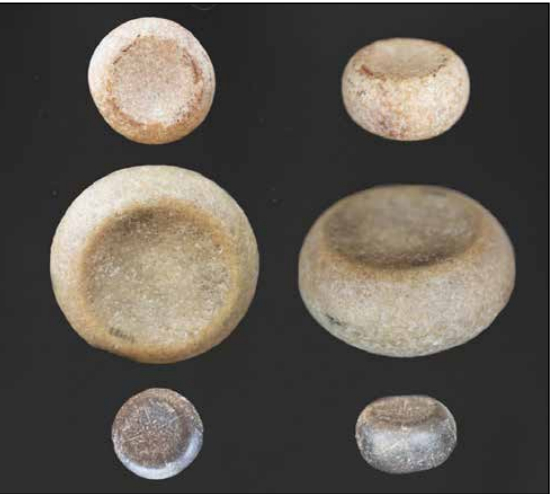|
This excerpt from "Discoidal Typology
from West Central Illinois" published
in the 2025 Central States Archaeological Societies 2025
October Journal
Read the complete column in the Central States
Archaeological Societies 2025
October Journal which can be purchased on-line after March 2026 |
 |
Figure 2. Jersey Bluff discoidals.
|
I was recently reading the April 2025 of CSAJ and saw a stunning puddingstone
discoidal on the back of the cover page and it struck me how often collectors
like to describe discoidals by stone type rather than typology and cultural
affiliation. A lot has also been written about discoidals in the context
of the game of Chunkee as played by the Native Americans; it’s much
harder to find information about discoidals in the archaeology context
and their typology.
The history of Chunkee begins in the area adjacent to Cahokia and spreads
to the surrounding geographic areas and with time, into the historic era
as documented by the early Spanish during the initial contact period. Many
have been pictured and displayed in various journals and books since collectors
love the aesthetic, overall beauty and rarity of the chunkee stone.
This article focuses primarily on the typology and timeline of the discoidal
and is based on Gregory Perino’s classification in 1971 as described
in the Illinois Archeology Survey Bulletin No 8. (Ref.1)
In my close to 30 years of walking campsites, I have only found one. I know
many local collectors that have found many rare and wonderful things but
never had the thrill of finding a discoidal. To hold a well-made discoidal
is to hold a piece of Native American art and history. At its essence is
a chunk of stone pecked , shaped, ground and polished into a universally
appreciated piece of art. The quality of work, selection of fine stone and
its depiction on Mississippian art suggests that the Native American also
appreciated it as much as a work of art as we do today.
This article will discuss the typology and timeline of the discoidal or
chunkee stone in west central Illinois, specifically Pike and Calhoun counties.
This area is sandwiched between the lower Illinois valley and the Mississippi
Bottom flood plain, west of the Jersey Bluffs and Green County, with Missouri
to the west and extending down south to the vicinity around Cahokia, Illinois.
The area is considered to be the birthplace and epicenter for the discoidal.
Although there are other types of discoidals, it is thought they all initially
developed around Cahokia and then later were traded from the Cahokia area,
subsequently developing their unique style locally-such as the Tennessee
and Georgia style discoidals.
Gregory Perino classified the discoidal in four types as illustrated...
Read other great columns in the Central States Archaeological Societies 2025
October Journal which can be purchased on-line after March 2026




